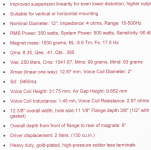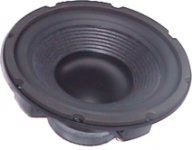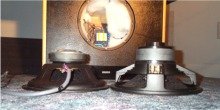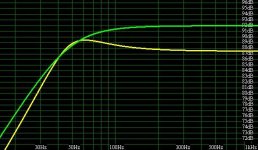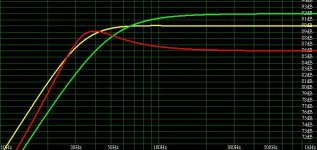Hi,
Just finished reading the old stereophile review of the speakers.
http://stereophile.com/floorloudspeakers/385ml/
Hmmm.... a lot of the comments are due to crossing over an
omni to a line source dipole and the way said things interact
with a room and the users listening distance.
2.5 ohm Re bass driver is very low for an 8 ohm nominal speaker.
Also lots and lots of waffle in the above review too,
woulf have preferred less waffle with measurements.
It is true a high mmd speaker is never go to make a bass/mid driver.
But your never going to find a 4 ohm 92dB driver that
works well in your box that has particularly high mmd.
The general problem with any driver is the higher the frequency
is remains clean and piston, the more severe the breakup modes
thereafter, for metal drivers you can notch filter the break up.
Stiffness and including damping is the holy grail, but the real
parameter is youngs modulus, stiffness for a given weight
i.e. the lower the density the better, but damping adds weight.
A tip - ripples on the impedance curve indicate cone effects.
Your main problem is 4 ohm drivers have been taken over
by car audio nuts, hi-fi for 4ohm generally uses two drivers
in parallel because of the more acceptable form factor.
12" car drivers are designed for ~ 1cuft sealed not 3 cuft.
And 4 ohm subwoofers (or 8+8 dual coil) are not generally
designed to be used with 1st order crossovers, midrange
quality is not considered an issue.
Like I've said already, you are going to have a hard
time finding a driver that is a suitable replacement.
🙂/sreten.
Just finished reading the old stereophile review of the speakers.
http://stereophile.com/floorloudspeakers/385ml/
Hmmm.... a lot of the comments are due to crossing over an
omni to a line source dipole and the way said things interact
with a room and the users listening distance.
2.5 ohm Re bass driver is very low for an 8 ohm nominal speaker.
Also lots and lots of waffle in the above review too,
woulf have preferred less waffle with measurements.
It is true a high mmd speaker is never go to make a bass/mid driver.
But your never going to find a 4 ohm 92dB driver that
works well in your box that has particularly high mmd.
The general problem with any driver is the higher the frequency
is remains clean and piston, the more severe the breakup modes
thereafter, for metal drivers you can notch filter the break up.
Stiffness and including damping is the holy grail, but the real
parameter is youngs modulus, stiffness for a given weight
i.e. the lower the density the better, but damping adds weight.
A tip - ripples on the impedance curve indicate cone effects.
Your main problem is 4 ohm drivers have been taken over
by car audio nuts, hi-fi for 4ohm generally uses two drivers
in parallel because of the more acceptable form factor.
12" car drivers are designed for ~ 1cuft sealed not 3 cuft.
And 4 ohm subwoofers (or 8+8 dual coil) are not generally
designed to be used with 1st order crossovers, midrange
quality is not considered an issue.
Like I've said already, you are going to have a hard
time finding a driver that is a suitable replacement.
🙂/sreten.
sreten said:
Hi, no, but I assume it doesn't matter, 🙂/sreten.
Tsk, Tsk..
Consider of few things:
1. Martin Logan doesn't make very efficent panels.
2. Their 90 db spec. is sensetivity - NOT eff.. (and its likely even this is a lie - probably 88 db sensetivity)
3. The nominal impeadance is 8 ohms.
4. This is a sealed design.
5. The spec'ed freq. range is an extraodinary (if optimistic) 28Hz–22kHz.
Now think a little harder about how the driver coils are being used. 😉
Here is the crossover of the Martin Logans, I doubt the ELS pannels are 92db efficeint so they would have cut back the efficeintcy of the Eminence to suit wouldn't they? So maybe I can use a lower effciency bass driver?
Cheers George
Cheers George
Attachments
ick..
It looks like its probably connected in parallel and the nominal 8 ohms is due to the added resistance. My opinion of Gale Sanders just dropped several notches (..even though this design is very old).
This is NOT how you want to design *any* standard moving coil based loudspeaker.
It looks like its probably connected in parallel and the nominal 8 ohms is due to the added resistance. My opinion of Gale Sanders just dropped several notches (..even though this design is very old).
This is NOT how you want to design *any* standard moving coil based loudspeaker.
ScottG said:
Tsk, Tsk..
Consider of few things:
1. Martin Logan doesn't make very efficent panels.
2. Their 90 db spec. is sensetivity - NOT eff.. (and its likely even this is a lie - probably 88 db sensetivity)
3. The nominal impeadance is 8 ohms.
4. This is a sealed design.
5. The spec'ed freq. range is an extraodinary (if optimistic) 28Hz–22kHz.
Now think a little harder about how the driver coils are being used. 😉
My bad. 😀
The switch that brings in the resistor is only a 3db bass cut if your in a small room were the bass can be too much. the inductors are large air core very thick wire and look to be of low resistance, so i cannot see how the ELS can mate with a 92db efficent bass driver, unless the Eminence specs are way off, or somehow Gale Sanders has managed to do the impossible and produced a ELS pannel that has 92db efficency?
Cheers George
Cheers George
large air core inductors have a fair amount of resistance - it is (all else equal) a good way to "pad" down a speaker.
the -3db switch however is bad.
..who knows though, the overall design could be so bad that you wouldn't hear the negative effects of its insertion with a good amplifier.
Have someone model the crossover to "see" *exactly* what its doing - only then will you be able to really "hunt" for new driver.
the -3db switch however is bad.
..who knows though, the overall design could be so bad that you wouldn't hear the negative effects of its insertion with a good amplifier.
Have someone model the crossover to "see" *exactly* what its doing - only then will you be able to really "hunt" for new driver.
NHT 1259
THe NHT 1259 4 ohm would be really close - 3.5 ohm and recommended enclosure is 3.5 ft3. Sensitivity is 89db.
THe NHT 1259 4 ohm would be really close - 3.5 ohm and recommended enclosure is 3.5 ft3. Sensitivity is 89db.
Re: NHT 1259
Please get out you multimeter and measure the DC resistance of :
a) The woofer
b) input switch on
c) input switch off
If the woofer is 2.5 Re and the inductors are very low DCR then
2R will cut levels more than 3dB, but the bass will come back up
again as the Qts of the driver will be changed drastically.
From ~ 0.4 to ~ 0.7 , inbox Q will change from ~ 0.65 to ~ 1.1.
A very good question is do you use this switch ?
I understand it gives an "alternative" bass response that
may or may not work better in difficult positions in rooms.
The crossover diagram is very helpful.
The bass unit c/o is 2nd order, give me the values above and I'll sim it.
your concerns about cone breakup should be much less with
To clarify one point : the specs given are for an Eminence driver
to match a driver provided by ML, presumably ML sourcing spares.
The driver provided by ML ? was this also an Eminence ?
Are you sure that it is the driver fitted to your speakers ?
You can check whether it has double voice coil connections.
If it hasn't its likely "the driver provided by ML".
Unfortunately currently unavailable as it is being redesigned.
Due to the fact that bass loudness curves are closely spaced,
(you ~ get an apparent 100dB range in an actual 50dB range)
the exact level of bass is more critical than most assume.
A 3dB reduction (92 to 89) will have a major effect. The 3dB
switch does not simulate this as it effects Q far too much.
You need to be very clear about whether it is acceptable to
reduce the voltage sensitivity of the bass unit. I can simulate
other effects e.g. diffrent Re and Le (assuming that the specs
in the original post are the specs of the driver currently fitted).
You could temporarily bi-amp one speaker (need a monoing lead)
and simulate this with your balance control to see if reduced
output level is acceptable.
Personally I'd be heading in the direction of replacing the 12"
with two 10" vertically aligned very low distortion units, I'd
probably go metal coned and add as trap circuit for break-up.
🙂/sreten.
georgehifi said:The switch that brings in the resistor is only a 3db bass cut if
your in a small room were the bass can be too much. the inductors
are large air core very thick wire and look to be of low resistance,
so i cannot see how the ELS can mate with a 92db efficent bass
driver, unless the Eminence specs are way off, or somehow Gale
Sanders has managed to do the impossible and produced a ELS
pannel that has 92db efficency?
Cheers George
Please get out you multimeter and measure the DC resistance of :
a) The woofer
b) input switch on
c) input switch off
If the woofer is 2.5 Re and the inductors are very low DCR then
2R will cut levels more than 3dB, but the bass will come back up
again as the Qts of the driver will be changed drastically.
From ~ 0.4 to ~ 0.7 , inbox Q will change from ~ 0.65 to ~ 1.1.
A very good question is do you use this switch ?
I understand it gives an "alternative" bass response that
may or may not work better in difficult positions in rooms.
The crossover diagram is very helpful.
The bass unit c/o is 2nd order, give me the values above and I'll sim it.
your concerns about cone breakup should be much less with
To clarify one point : the specs given are for an Eminence driver
to match a driver provided by ML, presumably ML sourcing spares.
The driver provided by ML ? was this also an Eminence ?
Are you sure that it is the driver fitted to your speakers ?
You can check whether it has double voice coil connections.
If it hasn't its likely "the driver provided by ML".
zlast said:THe NHT 1259 4 ohm would be really close -
3.5 ohm and recommended enclosure is 3.5 ft3.
Sensitivity is 89db.
Unfortunately currently unavailable as it is being redesigned.
Due to the fact that bass loudness curves are closely spaced,
(you ~ get an apparent 100dB range in an actual 50dB range)
the exact level of bass is more critical than most assume.
A 3dB reduction (92 to 89) will have a major effect. The 3dB
switch does not simulate this as it effects Q far too much.
You need to be very clear about whether it is acceptable to
reduce the voltage sensitivity of the bass unit. I can simulate
other effects e.g. diffrent Re and Le (assuming that the specs
in the original post are the specs of the driver currently fitted).
You could temporarily bi-amp one speaker (need a monoing lead)
and simulate this with your balance control to see if reduced
output level is acceptable.
Personally I'd be heading in the direction of replacing the 12"
with two 10" vertically aligned very low distortion units, I'd
probably go metal coned and add as trap circuit for break-up.
🙂/sreten.
And I've just had a blood rush and bought a pair of ACI SV12 and below is the specs on them, I hope they will do the job as all the others mentioned on this thread were going to cost a small fortune by the time they got to Australia, Let me know what you think.
Cheers George
Cheers George
Attachments
Hi,
seems I set Fs for the Eminence incorrectly in the previous
Sim, someone should have wrapped my knuckles for this.
So green = eminence, yellow = SV12, red = SV12 + switch.
I'll model with crossover later but it looks like
the 90dB sensitivity will be fine in practise.
🙂/sreten.
seems I set Fs for the Eminence incorrectly in the previous
Sim, someone should have wrapped my knuckles for this.
So green = eminence, yellow = SV12, red = SV12 + switch.
I'll model with crossover later but it looks like
the 90dB sensitivity will be fine in practise.
🙂/sreten.
Attachments
Hi,
I thought I had a trial version of a tool that would
analyse this but alas it does not give sensible results.
Back to my trusty circuit simulator.
It indicates the bass driver is rolled before it hits nominal sensitivity.
That is the Eminence never gets over 87/88dB.
It indicates the AC12 rolloff will be slightly shallower due to
the extra Re and Le, and it never gets over 87/88dB as well.
So ML have not done the "impossible" and made a 92dB panel.
It seems that it all balances out quite well and you will end up
with substantially deeper bass although somewhat less damped.
🙂/sreten.
I thought I had a trial version of a tool that would
analyse this but alas it does not give sensible results.
Back to my trusty circuit simulator.
It indicates the bass driver is rolled before it hits nominal sensitivity.
That is the Eminence never gets over 87/88dB.
It indicates the AC12 rolloff will be slightly shallower due to
the extra Re and Le, and it never gets over 87/88dB as well.
So ML have not done the "impossible" and made a 92dB panel.
It seems that it all balances out quite well and you will end up
with substantially deeper bass although somewhat less damped.
🙂/sreten.
That sound good Streten, once again thanks for your help,
So the SV12 is going to be a good subsitute esspecialy since it's only half the price of any of the others?
Do you think 100%, 50% 25% or no stuffing for the SV12 to get the tightess sounding bass, I don't mind sacrificing depth of bass for tightness?
Cheers George
So the SV12 is going to be a good subsitute esspecialy since it's only half the price of any of the others?
Do you think 100%, 50% 25% or no stuffing for the SV12 to get the tightess sounding bass, I don't mind sacrificing depth of bass for tightness?
Cheers George
Ho, and what QTC did you end up at with both Eminence and more importanty the SV12, I hope .707 or lower.
Cheers George
Cheers George
With my ordinary program it says the SV12 in 85lts will give a QTC of .78
But if it was 110lts I can get the ideal QTC of .707 Is this possible with 100% stuffing do you think? or is my program telling lies?
Cheers George
But if it was 110lts I can get the ideal QTC of .707 Is this possible with 100% stuffing do you think? or is my program telling lies?
Cheers George
- Status
- Not open for further replies.
- Home
- Loudspeakers
- Subwoofers
- Help, need good LF 12'' (300mm) driver

